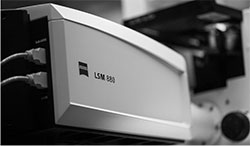Jon Sack, Ph.D.

Associate Professor
4153 Tupper Hall
Davis Campus
530-752-4131
jsack@health.ucdavis.edu
Lab Website
Research Interests
Reprogramming Neuronal Electrical Signaling with Targeted Ion Channel Modulation
Ion channel proteins are key regulators of electrical signals in cells, controlling neuronal communication and physiological functions as diverse as hormone secretion, cardiac rhythm, and muscle contraction. The human body expresses a multitude of ion channel types, each with distinct roles in cellular communication. The Sack lab investigates these channels' fundamental mechanisms and engineers molecular tools to both visualize and manipulate electrophysiological activity. We leverage these tools to reprogram neuronal electrical signaling relevant to a wide spectrum of clinical disorders—from cardiac arrhythmias to chronic pain. Our work focuses on selectively modulating ion channel activity to restore or enhance physiological functions. By finding modulators that alter the fundamental stimulus-response characteristic of channel function, we can reprogram neuronal electrical signaling for precise therapeutic benefits.
Imaging Ion Channel Activity in Real Time
Because ion channels open and close at speeds of hundreds of times per second, capturing their dynamics requires sophisticated techniques beyond conventional medical imaging. We have introduced novel probes that bind selectively to specific ion channel conformations, enabling us to visualize channel activity in real time without necessitating genetic or chemical modifications to the channels themselves. By conjugating these probes to fluorescent reporters and exploiting cutting-edge fluorescence microscopy, we can directly observe changes in ion channel behavior. This approach offers an unprecedented look at the electrical underpinnings of physiological and pathological states.
Graduate Group Affiliations
An updated list of current publications: PubMed
Stewart RG, Marquis MJ, Jo S, Aberra A, Cook V, Whiddon Z, Ferns M, Sack JT. "A Kv2 inhibitor combination reveals native neuronal conductances consistent with Kv2/KvS heteromers" eLife. 2024;13:e89145. doi:10.7554/eLife.89145.
Stewart RG, Camacena M, Copits BA, Sack JT. "Distinct cellular expression and subcellular localization of Kv2 voltage-gated K(+) channel subtypes in dorsal root ganglion neurons conserved between mice and humans." J Comp Neurol. 2024 Feb;532(2):e25575. doi: 10.1002/cne.25575.
Ferns M, van der List D, Vierra NC, Lacey T, Murray K, Kirmiz M, Stewart RG, Sack JT, Trimmer JS. "Electrically silent KvS subunits associate with native Kv2 channels in brain and impact diverse properties of channel function." bioRxiv. 2024 Jan 25;. doi: 10.1101/2024.01.25.577135.
Emigh Cortez AM, DeMarco KR, Furutani K, Bekker S, Sack JT, Wulff H, Clancy CE, Vorobyov I, Yarov-Yarovoy V. "Structural modeling of hERG channel-drug interactions using Rosetta." Front Pharmacol. 2023;14:1244166. doi: 10.3389/fphar.2023.1244166.
Kimball IH, Nguyen PT, Olivera BM, Sack JT, Yarov-Yarovoy V. "Molecular determinants of μ-conotoxin KIIIA interaction with the human voltage-gated sodium channel Na(V)1.7." Front Pharmacol. 2023;14:1156855. doi: 10.3389/fphar.2023.1156855.
Nguyen PT, Nguyen HM, Wagner KM, Stewart RG, Singh V, Thapa P, Chen YJ, Lillya MW, Ton AT, Kondo R, Ghetti A, Pennington MW, Hammock B, Griffith TN, Sack JT, Wulff H, Yarov-Yarovoy V. "Computational design of peptides to target Na(V)1.7 channel with high potency and selectivity for the treatment of pain." Elife. 2022 Dec 28;11. doi: 10.7554/eLife.81727.
Marquis MJ, Sack JT. “Mechanism of use-dependent Kv2 channel inhibition by RY785”. Journal of General Physiology 154:e202112981 (2022) doi: 10.1085/jgp.202112981.
Sepela RJ, Stewart RG, Valencia LA, Thapa P, Wang Z, Cohen BE, Sack JT. “The AMIGO1 adhesion protein activates Kv2.1 voltage sensors”. Biophysical Journal. (2022). doi: 10.1016/j.bpj.2022.03.020.
Sack JT. “K+ takes the crown: Selective activation of non-selective crown ether channels”. Biophysical Journal. 121:863-864 (2022) doi: 10.1016/j.bpj.2022.02.020.
Thapa P, Stewart R, Sepela RJ, Vivas O, Parajuli LK, Lillya M, Fletcher-Taylor S, Cohen BE, Zito K, Sack JT. “EVAP: A two-photon imaging tool to study conformational changes in endogenous Kv2 channels in live tissues”. Journal of General Physiology 153:e202012858 (2021)
Stewart R, Cohen BE, Sack JT. “Fluorescent toxins as ion channel activity sensors”. Methods in Enzymology 653:295-318. (2021) doi: 10.1016/bs.mie.2021.02.014.
Fletcher-Taylor S, Thapa P, Sepela RJ, Kaakati R, Yarov-Yarovoy V, Sack JT, Cohen BE. “Distinguishing Potassium Channel Resting State Conformations in Live Cells with Environment-Sensitive Fluorescence”. ACS Chemical Neuroscience (2020) doi:10.1021/acschemneuro.0c00276.
Tilley DC, Angueyra JM, Eum KS, Kim H, Chao LH, Peng AW, Sack JT. “The tarantula toxin GxTx detains K+ channel gating charges in their resting conformation”. Journal of General Physiology 151:292-315 (2019) doi:10.1085/jgp.201812213
Furutani K, Tsumoto K, Chen IS, Handa K, Yamakawa Y, Sack JT, Kurachi Y. “Facilitation of IKr current by some hERG channel blockers suppresses early afterdepolarizations”. Journal of General Physiology 151:214-230 (2019) doi:10.1085/jgp.201812192
Mann VR, Powers AS, Tilley DC, Sack JT, Cohen BE. “Azide-Alkyne Click Conjugation on Quantum Dots by Selective Copper Coordination”. ACS Nano 12, 4469-4477 (2018)
Kirmiz M, Palacio S, Thapa P, King AN, Sack JT, Trimmer JS. “Remodeling neuronal ER-PM junctions is a conserved nonconducting function of Kv2 plasma membrane ion channels”. Molecular Biology of the Cell 29: 2410-2432 (2018)
Dockendorff C, Gandhi DM, Kimball IH, Eum KS, Rusinova R, Ingolfsson HI, Kapoor R, Peyear T, Dodge MW, Martin SF, Aldrich RW, Andersen OS, Sack JT. “Synthetic Analogues of the Snail Toxin 6-Bromo-2-mercaptotryptamine Dimer (BrMT) Reveal That Lipid Bilayer Perturbation Does Not Underlie Its Modulation of Voltage-Gated Potassium Channels”. Biochemistry 57:2733-2743 (2018)
Sepela RJ, Sack JT. “Taming unruly chloride channel inhibitors with rational design”. Proceedings of the National Academy of Sciences of the United States of America 115:5311-5313 (2018)
Sack JT. “The envenomation of general physiology throughout the last century”. Journal of General Physiology 149:975-983 (2017)
Thiffault I, Speca DJ, Austin DC, Cobb MM, Eum KS, Safina NP, Grote L, Farrow EG, Miller N, Soden S, Kingsmore SF, Trimmer JS, Saunders CJ, Sack JT. “A novel epileptic encephalopathy mutation in KCNB1 disrupts Kv2.1 ion selectivity, expression, and localization”. Journal of General Physiology 146:399-410 (2015)
Sack JT, Tilley DC. “What keeps Kv channels small? The molecular physiology of modesty”. Journal of General Physiology 146:123-7 (2015)
Cobb MM, Austin DC, Sack JT, Trimmer JS. “Cell Cycle-dependent Changes in Localization and Phosphorylation of the Plasma Membrane Kv2.1 K+ Channel Impact Endoplasmic Reticulum Membrane Contact Sites in COS-1 Cells”. Journal of Biological Chemistry 290:29189-29201 (2015)
Chen-Izu Y, Shaw RM, Pitt GS, Yarov-Yarovoy V, Sack JT, Abriel H, Aldrich RW, Belardinelli L, Cannell MB, Catterall WA, Chazin WJ, Chiamvimonvat N, Deschenes I, Grandi E, Hund TJ, Izu LT, Maier LS, Maltsev VA, Marionneau C, Mohler PJ, Rajamani S, Rasmusson RL, Sobie EA, Clancy CE, Bers D., “Na+ Channel Function, Regulation, Structure, Trafficking and Sequestration”. Journal of Physiology 593:1347-60 (2015)
Gupta K, Zamanian M, Bae C, Milescu M, Krepkiy D, Tilley DC, Sack JT, Yarov-Yarovoy V, Kim JI, Swartz KJ. “Tarantula toxins use common surfaces for interacting with Kv and ASIC ion channels”. eLife, 4:e06774 (2015)
Sack JT, Eum KS. Ion channel Inhibitors. Handbook of Ion Channels. CRC Press, eds J. Zheng & M. C. Trudeau. Ch. 14, 189-197 (2015)
Tilley D, Eum KS, Fletcher-Taylor S, Austin DA, Dupre C, Patron L, Garcia R, Lam K, Yarov-Yarovoy V, Cohen BE, Sack JT. “Chemoselective tarantula toxins report activation of wild-type ion channels in live cells”. Proceedings of the National Academy of Sciences of the United States of America 111: E4789–E4796 (2014)
Ingólfsson HI, Thakur P, Herold KF, Maretzky T, Hall K, Zwama M, Yilmaz D, Hemmings HC, Blobel C, Koçer A, Sack JT, Andersen OS. “Phytochemicals perturb membranes and promiscuously alter protein function”. ACS Chemical Biology 9:1788-98 (2014)
Speca DJ, Ogata G, Mandikian D, Wiler SW, Eum K, Wenzel HJ, Doisy ET, Matt L, Campi KL, Golub MS, Nerbonne JM, Hell JW, Trainor BC, Sack JT, Schwartzkroin PA, Trimmer JS. “Deletion of the Kv2.1 delayed rectifier potassium channel leads to neuronal and behavioral hyperexcitability”. Genes, Brain and Behavior 13:394-408 (2014)
Sack JT, Stephanopoulos N, Austin DC, Francis MB, Trimmer JS. “Antibody-guided photoablation of voltage-gated potassium currents”. Journal of General Physiology 142:315-324 (2013)




 Make a donation using our secure online system.
Make a donation using our secure online system.